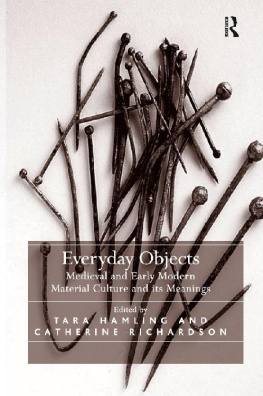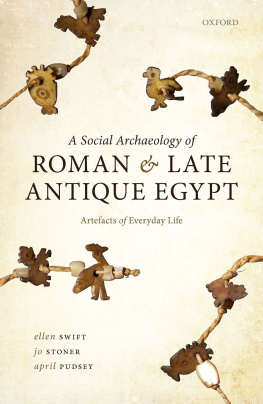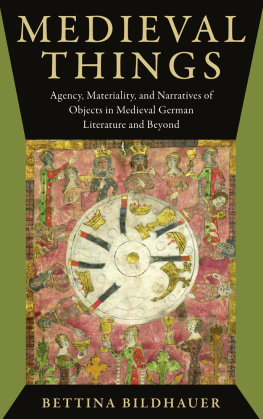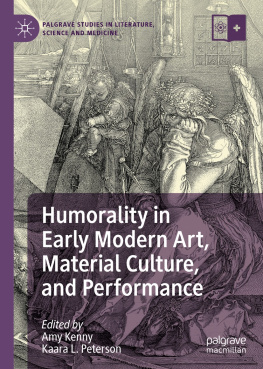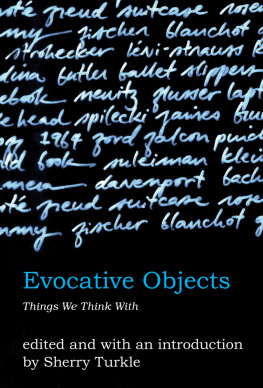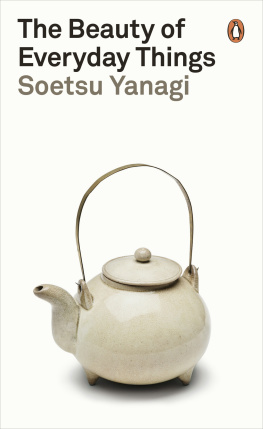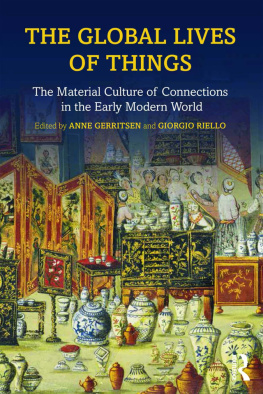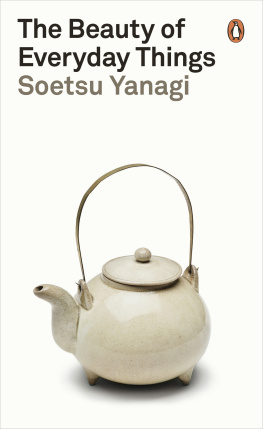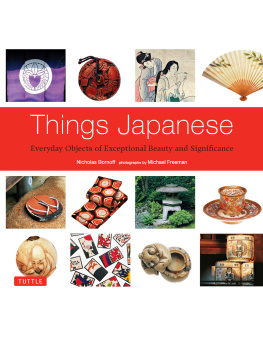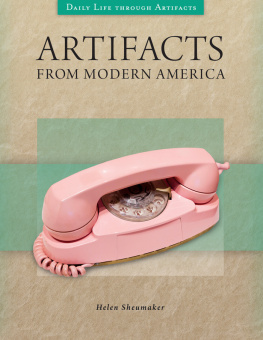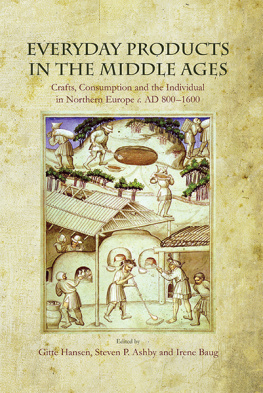
EVERYDAY OBJECTS
This book is for our girls, Madaleine and Darcy, who have both
helped and hindered its progress in so many ways.
Everyday Objects
Medieval and Early Modern Material Culture
and its Meanings
Edited by Tara Hamling and Catherine Richardson

First published 2010 by Ashgate Publishing
Published 2016 by Taylor & Francis
2 Park Square, Milton Park, Abingdon, Oxon OX14 4RN
711 Third Avenue, New York, NY 10017, USA
Routledge is an imprint of the Taylor & Francis Group, an informa business
Copyright 2010 The editors and contributors
Tara Hamling and Catherine Richardson have asserted their right under the Copyright, Designs and Patents Act, 1988, to be identified as the editors of this work.
All rights reserved. No part of this book may be reprinted or reproduced or utilised in any form or by any electronic, mechanical, or other means, now known or hereafter invented, including photocopying and recording, or in any information storage or retrieval system, without permission in writing from the publishers.
Notice:
Product or corporate names may be trademarks or registered trademarks, and are used only for identification and explanation without intent to infringe.
British Library Cataloguing in Publication Data
Everyday objects : medieval and early modern material culture and its meanings.
1. Material culture History.
I. Hamling, Tara. II. Richardson, Catherine.
306.460902dc22
Library of Congress Cataloging-in-Publication Data
Hamling, Tara.
Everyday objects : medieval and early modern material culture and its meanings / Tara Hamling and Catherine Richardson.
p. cm.
Includes bibliographical references and index.
ISBN 978-0-7546-6637-0 (hardcover : alk. paper)
1. Material culture History. 2. Civilization, Medieval. 3. Civilization, Modern.
I. Richardson, Catherine. II. Title.
GN406.H36 2009
930.1dc22
2009034595
ISBN 9780754666370 (hbk)
Table of Contents: Themes
Sara Pennell
Giorgio Riello
Stephen Kelly
Mark Chambers and Louise Sylvester
Jenny Tiramani
Natasha Korda
Maria Hayward
Stephen Wharton
David Gaimster
Dinah Eastop
Tarnya Cooper
Robert Tittler
Flora Dennis
Jonathan Willis
John J. Thompson
R.N. Swanson
Richard L. Williams
Sheila Sweetinburgh
Kate Giles
Catherine Richardson
Lena Cowen Orlin
Ryan Perry
Tara Hamling
Table of Contents: Objects
Clothing
Jenny Tiramani
Natasha Korda
Maria Hayward
Dinah Eastop
Catherine Richardson
Shoes
Giorgio Riello
Stephen Kelly
Mark Chambers and Louise Sylvester
Tableware
Sara Pennell
Steve Wharton
Sheila Sweetinburgh
Musical Instruments
Flora Dennis
Jonathan Willis
John J. Thompson
Books
R.N. Swanson
Ryan Perry
Portraits
Tarnya Cooper
Robert Tittler
Domestic Goods
David Gaimster
Lena Cowen Orlin
Tara Hamling
Ritual Objects
Richard L. Williams
Sheila Sweetinburgh
Buildings and Fixtures
Kate Giles
Tara Hamling
Colour Plates between pages 132and 133
Mark Chambers is a Research Associate at the University of Westminster and a post-doctoral Research Assistant on the Lexis of Cloth and Clothing in Medieval Britain Project, and he has taught medieval literature at Trinity College Dublin and at the University of Durham. He has recently published articles on the lexicology of medieval cloth and clothing in Philological Quarterly (winter, 2004) and in Medieval Clothing and Textiles (4: 2008). His research interests include lexicology of medieval fashion, sumptuary legislation in the fourteenth through the sixteenth centuries and theories of dramatic allegory.
Tarnya Cooper is Curator of sixteenth century collections at the National Portrait Gallery. She gained her D.Phil in Tudor and Jacobean portraiture from the University of Sussex in 2002. She co-curated the Elizabeth exhibition at the National Maritime Museum in 2003 and curated the exhibition Searching for Shakespeare at the National Portrait Gallery in 2006. She is currently working on a book about portraiture and the rise of the middling sorts in the Tudor and Jacobean period.
Flora Dennis is Lecturer in Art History at the University of Sussex. After completing a doctorate in musicology at the University of Cambridge, she was a Research Fellow at the AHRC Centre for the Study of the Domestic Interior, co-curating the V&A exhibition At Home in Renaissance Italy and co-editing its accompanying book. Her research focuses on relationships between Italian Renaissance visual and material culture, music and sound.
Dinah Eastop, PhD, FIIC, ACR Senior Lecturer, Textile Conservation Centre (TCC), UK (19992010) and Founding Director of the AHRC Research Centre for Textile Conservation and Textile Studies (20022007), an interdisciplinary research partnership between the Universities of Southampton, Bradford and Manchester is from 2010 Consultant in Conservation and Heritage Studies; Visiting Research Fellow, University of Southampton; Honorary Lecturer, Institute of Archaeology, UCL. She co-authored Chemical Principles of TextileConservation (with Dr gnes Timr-Balzsy, 1998) and co-edited Upholstery Conservation: Principles and Practice (with Kathryn Gill, 2001). Her research focuses on the dynamic interplay between the material properties and social attributes of objects and its effects on conservation and curatorial decisions. She initiated and leads the Deliberately Concealed Garments Project (www.concealedgarments.org).
David Gaimster is Director of the Hunterian Museum and Art Gallery, Glasgow University. Previously he was General Secretary of the Society of Antiquaries of London following posts at the British Museum and Department for Culture, Media and Sport. He is a Visiting Professor at the Centre for Historical Archaeology, Leicester University, and Associate Professor in the Department of Cultural Studies, University of Turku, Finland. He has published widely on late medieval to early modern European archaeology and material culture and also on international cultural property policy issues. He was awarded the Order of Merit by the Society for Historical Archaeology in 2005.
Kate Giles is a Lecturer in the Department of Archaeology and the York Minster Archaeological Research Fellow. She specialises in the archaeology of buildings, particularly medieval and early modern public buildings and in the relationship between architecture, space and material culture. Having worked on Yorks guildhalls, she has recently worked on Boston guildhall (Lincs) and Stratford-upon-Avon (Warwickshire). She is currently working on a book on pre-modern buildings for Cambridge University Press.
Next page
